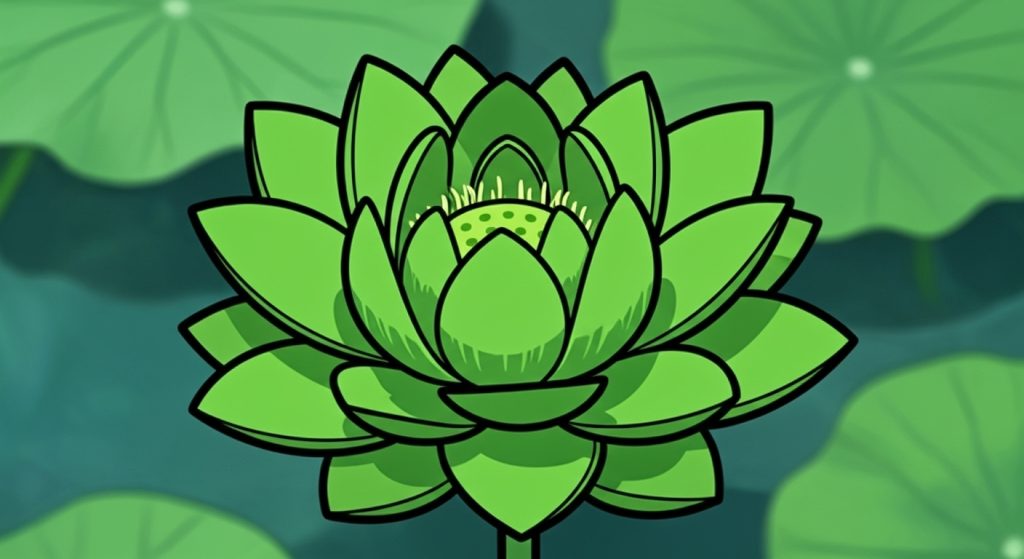The Green Lotus is more than just a flower — it’s a living symbol of purity, rebirth, and peace. Found floating gracefully on still waters, this rare lotus variety has fascinated botanists, spiritual seekers, and nature lovers for centuries. From its stunning appearance to its deep-rooted symbolism in culture and medicine, the Green Lotus holds a mysterious charm that few plants can match.
In this article, we’ll explore everything about the Green Lotus — its origins, cultivation, meanings, uses, and its growing importance in trade and conservation. Let’s dive into the serene world of this beautiful bloom.
What is a Green Lotus?
The Green Lotus refers to a unique variety of lotus flower that features soft green-tinted petals, a symbol of nature’s balance and renewal. Botanically, it belongs to the Nelumbo genus, commonly known as the sacred lotus. Unlike the typical pink or white lotus, this variety has a subtle green hue that gives it an otherworldly appearance.
In many Asian cultures, the Green Lotus symbolizes growth, prosperity, and inner peace. It represents a state of harmony — where life flourishes even in murky waters. Just like how the lotus rises from mud to bloom beautifully, it reminds us of hope and resilience.
Botanical Identity and Varieties
Scientific Classification
-
Kingdom: Plantae
-
Family: Nelumbonaceae
-
Genus: Nelumbo
-
Species: N. nucifera
While the true Green Lotus is rare in the wild, some cultivars and hybrids show varying degrees of green pigmentation. Horticulturists have even developed ornamental forms with soft lime or pale green shades for ponds and gardens.
Physical Characteristics
The Green Lotus is an aquatic perennial with large circular leaves and showy blossoms. Its leaves are water-repellent, symbolizing purity — water simply rolls off them. The flower itself grows above the water surface, unfolding its petals with grace, sometimes reaching a diameter of 8 to 12 inches.
Varieties and Cultivars
Some known cultivars like ‘Green Maiden’, ‘Emerald Dawn’, and ‘Green Star’ display subtle green tones. The Green Lotus Peony, although not a true lotus, is another popular ornamental plant inspired by its color and form.
Ideal Growing Conditions for Green Lotus
Environment and Habitat
The Green Lotus thrives in sunny, tropical to subtropical climates. It prefers still or slow-moving water such as ponds, lakes, or decorative garden basins. The plant needs at least six hours of sunlight daily to bloom fully.
Soil and Water Requirements
The roots of the lotus anchor in muddy or clay-rich soil, while the leaves and flowers float gracefully on the surface. A nutrient-rich aquatic substrate promotes strong growth. Clean water and proper depth (around 2 to 4 feet) ensure healthy development.
Propagation Techniques
There are two main ways to grow Green Lotus:
-
From seeds: Seeds can be germinated indoors and later transferred to water containers or ponds.
-
From rhizomes: This is the easiest and most common method. Divide a mature plant’s rhizome and replant it in a new pot or pond.
Care and Maintenance
The Green Lotus doesn’t require much maintenance once established. Regular removal of dead leaves, prevention of algae, and keeping pests like aphids away ensure vibrant blooms. In colder regions, the plant can be overwintered indoors to protect it from frost.
Uses and Applications of Green Lotus
1. Ornamental and Aesthetic Use
The Green Lotus is widely admired for its beauty. Gardeners use it to create tranquil landscapes, often placing it in ornamental ponds or temple gardens. The green hue contrasts beautifully with the blue sky and reflective water, making it a natural centerpiece.
2. Culinary Uses
Certain parts of the lotus plant are edible. The seeds, often called lotus nuts, are consumed roasted or ground into flour. The rhizomes are used in Asian cuisines for soups and stir-fries, valued for their mild, earthy taste.
3. Medicinal and Traditional Applications
For centuries, different parts of the lotus — leaves, flowers, and seeds — have been used in Ayurvedic and Chinese medicine. They are believed to have antioxidant, anti-inflammatory, and stress-relieving properties. The flower is also used in herbal teas for promoting relaxation and mental clarity.
4. Cultural and Spiritual Symbolism
In Buddhist and Hindu traditions, the lotus flower represents spiritual awakening and enlightenment. The green color adds a deeper layer of meaning — symbolizing growth, vitality, and balance. It’s a reminder that even in murky circumstances, one can rise and bloom gracefully.
Green Lotus in Art and Symbolism
The Green Lotus has been a subject of art, poetry, and religious imagery for centuries. In many temples and paintings, the lotus serves as a seat of divinity — representing purity amidst chaos. The green hue specifically conveys renewal and prosperity, making it a powerful emblem of hope.
Think of it this way: the lotus is like a person’s journey through life. It starts in the mud (struggle), rises through the water (growth), and finally blossoms in the sunlight (enlightenment).
Commercial Importance and Trade
Market Demand
The Green Lotus is gaining popularity in landscape design, botanical collections, and decorative exports. Its demand is particularly high in Asia, the United States, and Europe, where water gardens have become a symbol of luxury and peace.
Price and Availability
The price of a Green Lotus plant can vary depending on size, maturity, and rarity. On average, small plants or rhizomes may range from $15 to $30, while mature flowering plants can cost significantly more.
Suppliers and Sources
Many nurseries and online plant stores sell Green Lotus seeds and rhizomes. Trusted sources include Play It Koi, Ten Mile Creek Nursery, and Champlain Peony Company, all offering high-quality varieties suited for home cultivation.
Conservation and Sustainability
Threats to Wild Lotus Populations
In their natural habitats, lotus populations are under threat from water pollution, habitat destruction, and overharvesting. These environmental pressures make sustainable cultivation practices even more important.
Conservation Efforts
Several botanical gardens and conservation organizations have taken steps to preserve rare lotus species. Projects focusing on seed banking, habitat restoration, and public awareness help ensure the lotus continues to thrive for future generations.
Eco-Friendly Cultivation
Using organic fertilizers, maintaining clean water, and avoiding chemical pesticides are key steps for sustainable lotus gardening. By promoting eco-conscious cultivation, growers contribute to a healthier aquatic ecosystem.
The Role of Green Lotus in Ecosystems
The Green Lotus isn’t just beautiful — it’s beneficial for the environment. Its large leaves provide shade for aquatic life, reducing algae growth and maintaining oxygen levels. It also offers habitat and food for fish, frogs, and insects, making it an essential part of pond ecosystems.
Future Trends and Research Directions
Scientists and horticulturists are now studying the lotus for more than just beauty. Its genetic resilience and self-cleaning properties have sparked interest in biotechnology and material science. Future research aims to use lotus-inspired surfaces in self-cleaning coatings, fabrics, and solar panels.
Moreover, breeders are experimenting with new hybrids — aiming for enhanced colors, longer blooming periods, and greater adaptability to various climates.
Practical Tips for Growing Green Lotus at Home
If you’ve ever dreamed of adding this serene beauty to your garden, here’s how to begin:
-
Choose a sunny spot — the plant loves warmth and light.
-
Use a wide, shallow container or pond to allow leaves to spread.
-
Plant the rhizome horizontally in muddy soil, and keep the water level just above the leaf tips initially.
-
Change the water every few weeks if you’re using a container setup.
-
Fertilize with slow-release aquatic plant food once every 4–6 weeks during the growing season.
With a little care, your Green Lotus will reward you with lush blooms and calm energy — turning your garden into a living sanctuary.
Conclusion
The Green Lotus stands as a timeless reminder that beauty can emerge even from the most challenging environments. It symbolizes resilience, renewal, and peace, inspiring people across cultures and centuries. Whether admired in a temple pond or grown in your backyard, this rare flower continues to captivate hearts and minds.
Its importance stretches far beyond its petals — it’s a bridge between nature, culture, and spirituality. And in today’s fast-paced world, the Green Lotus teaches us a simple but powerful lesson: growth takes time, patience, and faith.
FAQs
1. What makes the Green Lotus different from other lotus flowers?
The Green Lotus stands out for its soft green hue and its symbolic meaning of growth and renewal. While most lotus flowers are pink or white, the green variant is rarer and often cultivated for ornamental and spiritual purposes.
2. Can I grow a Green Lotus at home?
Yes, absolutely. The Green Lotus can be grown in a pond, water tub, or large container. It requires ample sunlight, muddy soil, and clean water to thrive.
3. What does the Green Lotus symbolize spiritually?
Spiritually, the Green Lotus represents life, balance, and healing. It reminds us to stay grounded while growing toward enlightenment — just as the lotus rises above the mud to bloom in the sun.
4. Are Green Lotus plants expensive?
The price depends on the size and rarity of the variety. Smaller plants or rhizomes are usually affordable, while mature flowering plants can be more costly due to their ornamental value.
5. How can we protect natural lotus populations?
Supporting sustainable farming, avoiding pollution of water bodies, and purchasing from certified nurseries can help protect wild lotus populations and promote ecological balance.


